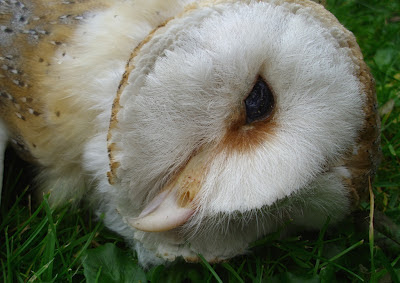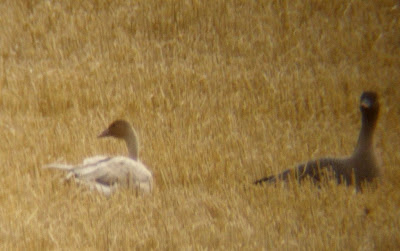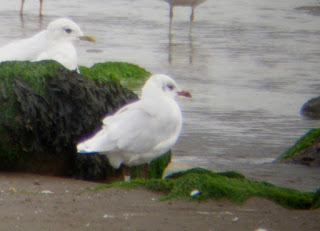Scanning the Forth on Friday produced very little probably due to lack of wind, only point of note was a feeding flock of Kittiwakes a good 2+ miles offshore but perhaps 3 miles long, probably >1k birds.
Saturday morning was little better at Ferny Ness, with a trickle of Mipits, one Grey Wag and a unusual Yellowhammer (perhaps not a true migrant?), nothing to compare with large hauls of passerines on Fife side, and still no skuas (full counts) (perhaps 1500 Kittiwakes feeding offshore). Then at 8:20hrs spotted a large-ish raptor well offshore out to the NE, initial thoughts of eared owl quickly became "large diurnal raptor" then as it approached it became apparent it must be a Marsh Harrier. Gained height as it approached the coast till nearly directly overhead, scope-filling views at one point (but given low expectations upon leaving home had not bothered to root out camera, so frustratingly no pics!) At this point it seemed to be on a trajectory SW heading directly for our house so I made off home but sadly never saw it again.
Anyway, it was a male, based on obvious grey panel on rear of upper wing, but underparts had very little pale grey evident and were mainly brown with bars/striations; the plumage of young male Marsh Harriers evolves with age, some helpful pics on Pewit's blog at least showing variability (1st/2nd sum - lower pics, 2nd-sum, young adult, another young adult and an old adult). Today's bird a reasonable match for the two young adults, certainly more advanced than the 2nd-sum, but nothing resembling the old adult. No tags visible either.
Afternoon - whilst at Seton looking at various Med Gulls on the burn got a text to inform me there were 6 there when I could only see 5 (!) - couldn't believe that the Lothian record (6 on 13/11/10) had again been matched this time actually being there
in situ but still missing it - however transpired there was double counting of a 2nd/3rd-win which Ian had also been watching (white-32A4 shown right)! The others were red-7P8 (recognisable from her yellow tip bill before legs became visible), 2 white-headed unringed adults and a classic 2nd-winter (all together on sand). Then an adult with a mask behind eye appeared in burn, which photos (one below) confirmed was different, so 6 after all. Given there had been three 2nd/3rd-win last week decided to have another look at dusk and indeed there were two different 2nd-win (plus two pale-headed adults and red-7P8) so a total of 7 altogether, though not all in view at once. We can probably expect many more given the Northumbs peak
has risen from 3 in 2005 to 68 last year, with Scottish peak rising to 12 in Fife in same period.
Also at dusk 44 Pinks flew SW over Gosford Sands and c. 62 large geese flew past Seton over Gosford Bay, of which c. 52 Canada, perhaps 4 good Greylags, 2+ Greylag x Canada hybrid and a white-headed hybrid; they flew in towards Gosford House. Ian tells me there were 55 Canadas in the estate a fortnight ago so it seems likely these are local birds not moult migrants - indeed the white-headed bird could be our old friend from the Esk. If they are locals then perhaps same as 33/34 on 16 & 24 August. We've not previously had a local resident flock here as far as I know (my only previous record in Gosford being a single on 4/10/08).
Continuing on the theme of "less desirable" species our garden Woodpigeon has again pulverised our garden stone-crop (Sedum caeruleum) for lining its nest. Given their great abundance not surprising that they are quite a common shorebird at Seton too, see top pic - this is a rather bleached adult with plenty of brown in the wing, not a youngster.
Sunday - Pinks were passing over high S first thing in the morning (some had already reached Titchwell by yesterday); then Bryan kindly alerted us all to the fact that the Pilot Whales were off Cockenzie, arriving at my usual seawatching spot on the bank above Cockenzie harbour to find a crowd of twitchers, well perhaps double figures including us! Met Morg in the field for first time in years - and he also got some footage documenting the event, my own photos were dire. During early phase of viewing around noon a bunch seemed to be circling, but soon afterwards they started motoring WNW, heading directly for Inchkeith; as time went on they steadily veered N then NNE in a great arc and by 14:30hrs I judged they were well over on the Fife side heading towards Largo Bay. My own count was 17 animals, 2 or more were smaller calves.
Otherwise - Seton foreshore held 470+ Golden Plover (37+ in image below, not easy to see on the barnacle rocks!) and first 4 Teal I had seen back, following first couple of Wigeon on Friday. Not much effort on Med Gulls but at least one adult there. Back home and the 60 odd mainly Canadas came over the house just before 18:00hrs, so they are certainly not on active moult migration, looks like the local Edinburgh/Musselburgh gang have taken to roosting at Gosford, not a particularly welcome development though it provides a bit of variety with a species never seen from garden in 8 years until a couple of weeks ago. House Martins still feeding young in the nest on our next door neighbour's house, with 27 over in the evening.

Monday morning - 40 Shags on Wrecked Craigs with several darvics; briefly scanned offshore looking for the whales and had a couple of Red-throated Divers W past, within the next couple of minutes another 13 went west, could have been many more had I had more time to watch. Also received a report that the Sandwich Tern red-ESF
seen at Montrose on 11 August had been up at Cairnbulg near Fraserburgh on Saturday - whilst here in the Forth they have diminished drastically in last couple of weeks; just goes to show that their migration is not as simple as one might assume!
Tuesday early hours - nocturnal migrant Sandwich Terns (ad+juv) SW over as rain was clearing; numbers have dwindled rapidly (my counts: 385 7/7; 280 11/8; 110 26/8; 73 1/9; 12 7/9).

























